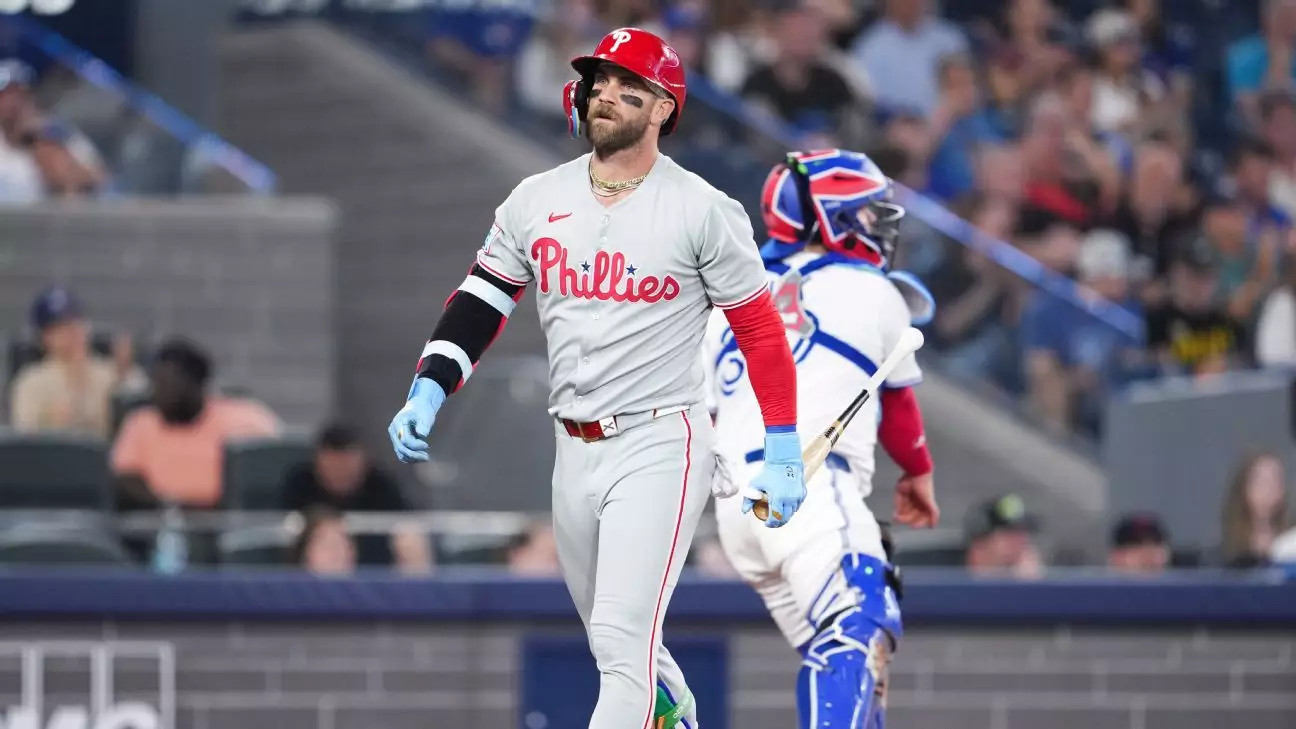Bryce Harper’s journey through this season has been as much a testament to perseverance as it has been a reminder of the physical toll professional sports exact on athletes. Plagued by persistent inflammation in his right wrist, Harper has battled discomfort that began last season and escalated to a monthlong stint on the injured list this year. Despite the setbacks, Harper’s recent return to the Phillies’ lineup signifies not just recovery but a critical turning point for the team, which has been navigating a precarious stretch without one of its cornerstone players.
His struggle highlights a vital challenge in professional baseball: managing chronic injuries while maintaining elite performance. Harper’s effort to continue playing through pain—demonstrated by his respectable .258 batting average and nine home runs over 57 games—reflects a gritty determination that often goes unnoticed amidst the statistics. Yet, it also raises questions about how much wear and tear athletes endure before they prioritize long-term health over immediate gains. Harper’s ability to perform under duress reaffirms his elite status but should also remind us of the delicate balance between ambition and wellness.
Role Adaptability: More Than Just a Slugger
One intriguing aspect of Harper’s return is the possibility of role flexibility that it introduces for the Phillies. Traditionally a dominant force at the plate and in the outfield, his upcoming appearances might not be confined to his accustomed positions. With Kyle Schwarber excelling as a designated hitter, the Phillies are now faced with strategic decisions about how best to utilize Harper’s offensive firepower while managing his physical condition.
Harper’s openness to the designated hitter role, should it become necessary, showcases a professional maturity that seeks to align personal output with team needs. This adaptability could prove pivotal, affording the Phillies lineup increased depth and durability. While the specifics remain uncertain—Manager Rob Thomson is deliberately cautious about declaring Harper’s day-to-day status—the mere prospect of Harper adjusting his role is promising for a team looking to sustain momentum through a long and arduous season.
Rookie Opportunity and Team Dynamics
Harper’s absence created a valuable opening for rookie Otto Kemp, whose promotion to the major leagues has injected fresh energy into the Phillies’ roster. Kemp’s versatility—adept both at third base and in the outfield—has offered the Phillies multiple tactical options. Recording 10 RBIs in just 20 games, Kemp has not only filled the void but also presented a genuine case for extended playing time.
This dynamic introduces an encouraging competitive element within the team, signaling a healthy evolution where emerging talents coexist with established stars. The Phillies’ willingness to integrate Kemp so seamlessly reflects a forward-thinking organizational mindset that combines immediate results with future planning. Harper’s return thus adds a layer of complexity to team chemistry but potentially enriches the lineup’s overall potency.
Leadership Amidst Challenges
Beyond statistics and positions, Harper’s return is symbolic of leadership and resilience. As a two-time National League MVP and eight-time All-Star, his impact transcends numbers. His contributions have been central to the Phillies’ recent postseason runs, including their dramatic 2022 playoff campaign where he earned NLCS MVP honors.
Injuries and adversities could have diminished Harper’s influence, but his commitment to come back stronger serves as a rallying point for teammates and fans alike. It underscores a characteristic often undervalued in professional sports: the mental fortitude to confront setbacks without losing sight of collective goals. For a Phillies team still atop the competitive NL East despite near equilibrium in wins and losses during Harper’s absence, his presence is as much a psychological boost as it is a tactical advantage.
—
Bryce Harper’s narrative this season is a rich tapestry interwoven with perseverance, adaptability, and leadership. His fight through injury, willingness to embrace new roles, and the emergence of young talent around him create a compelling story of resilience in professional baseball—one that promises exciting developments as the Phillies chase postseason success.


Leave a Reply